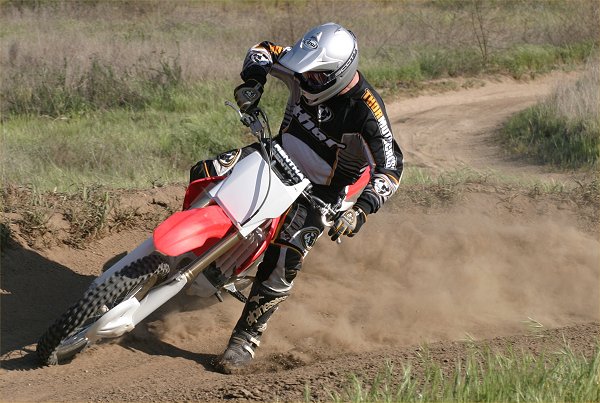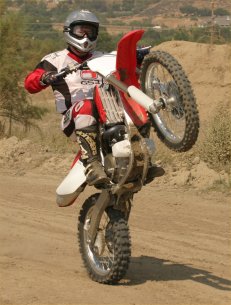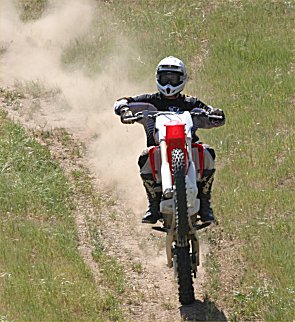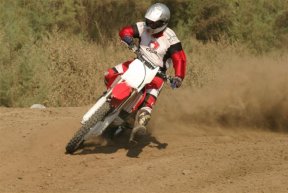
We’ve spent quite a bit of time with Honda’s 2004 CRF450R, and you have heard my Dad’s take on it (he loves this bike). It took me a bit longer to get in tune with the 450R, but in the end, I reached many of the same conclusions that my father did (by the way, this article is filled with pictures of Dirck Edge, not me).
Like a lot of our readers, I’ve long considered myself a “two-stroke guy”. I’ve been riding two-stroke MX bikes on the track and the trail for half my life, and my whole impression of what a dirt bike should be is based around two-strokes. That’s why I find myself somewhat surprised with the conclusion I come to after spending several months with our 2004 CRF450R long-term test bike: the big CR is the best dirt bike I’ve ever ridden.
I almost feel like I could end the article there, but I suppose that statement deserves some explanation. Let me start by saying that, initially, I didn’t like the 450 very much. Riding it just felt weird, and when I went to the track or trail riding with the family, I preferred to stick with one of our 250 two-stroke MX bikes. Especially on an MX track, where I felt that the 450 was just too much bike to throw around.

The first time I realized my opinion was beginning to change was on a weekend practice day at Cahuilla Creek MX Park. I was at the track by myself, so I decided to spend the day working on the suspension setup. I made a few changes after my first session, and suddenly my discomfort in the CR’s saddle was forgotten. With the right suspension setup, the front end sticks even in flat corners, and provides excellent feedback. The traction and control available from the back end is unbelievable. The ability to throw the bike in hard on the brakes, smoothly transition from brake slide to power slide, and then hook the back wheel up exactly when you want to is a real confidence builder. In fact, that last part is the most important. Hard on the throttle exiting a corner, the 450 seems to have an almost magical ability to stop power sliding and start digging at the perfect moment. This is a result of both the smooth powerband and the bike’s excellent response to body english (i.e. weight transfer).
The bike’s suspension also manages to handle every obstacle encountered on the trail or on the track with poise and control, striking an excellent balance between plushness and bottoming resistance. In my time with the CR, I’ve encountered everything from unexpected G-outs on the trail to hard landings from big jumps, as well as spending quite a bit of time in the whoops. Once I got my setup right, I have never felt dissatisfied in any way with the suspension’s performance.
The Honda’s motor is another of the strong points that make the bike a pleasure to ride. The power is deceptive at first, mostly due to the smoothness of the power delivery. Without the “hit” that characterizes a two-stroke, the bike seems to lack the immediate snap of its two-stroke rivals. This is actually a benefit, as it makes the bike much less tiring to ride, because its reactions to throttle inputs are less abrupt. The throttle response, however, is in no way soft or delayed. With just a blip of the throttle, the CRF450R will lift the front wheel easily in the first three gears, and even in fourth the bike’s wide spread of torque will help carry the front wheel over rolling whoops or dips in the trail.

Our test unit has been perfectly reliable in our time with it – in fact we have encountered no mechanical problems whatsoever. The bike does require two different types of oil (and two different procedures) for the crankcase and the transmission, which is slightly confusing at first, but not really a big deal. I try to change the crankcase oil as often as I can, which usually turns out to be every 5-6 rides. Of course, I recommend that owners follow Honda’s maintenance schedule.

Part of the reason I rate the 450 so highly is its versatility. Being a comparative lightweight (145 lbs) and not having anywhere near a serious racer’s endurance, I find a 250 4-stroke a better choice for the MX track, but not by much. Riding a full-on pace, I can keep going much longer on the smaller thumpers due to their lighter weight and softer power. On the trail, I prefer the 450 because of its broad spread of easy to use power. Although I spend most of my time on the faster, sometimes whooped-out trails common in California, I have on several occasions chased my good friend John’s Gas Gas 200 enduro bike on tight (1st and 2nd gear), rocky, single-track with lots of elevation changes. Following a bike which seems to have been designed with just such an environment in mind, I felt comfortable enough on the 450 to run his pace on this terrain.
Most riders can’t have two bikes in the garage. If I had to choose one bike to buy for all-around riding (MX and West Coast-style trail riding) the CRF450R would definitely be it. The 450 would be an even easier choice if I was heavier or if my skill level on an MX track was sufficient to really use the bike’s full power. Personally, I think for the average rider, the CRF450R is a better choice than a 250 two-stroke MX for about any situation. It might take a little while to adapt to riding a four-stroke, but once you do, I think you’ll reach the same conclusion I did.
I am ending this article with a photo of our friend Mike Metzger’s tricked-out Super Moto bike. It started life as a stock CRF450R, but received plenty of goodies, such as a 50mm Marzocchi fork. From attending several Super Moto races, I can tell you that the CRF450R is the bike of choice among privateers racing Super Moto. It really requires very few modifications (other than the ordinary street wheels, tires and brakes) to be competitive and fun. Metzger told us that he raced a stock CRF450R in Japan a couple of months ago against several Japanese pros, and finished second despite a very poor start (I believe he ended the first lap in ninth). Since we attend plenty of off-road events here at MD, we can tell you that we have seen the CRF450R competitive at everything from pro flat track to pro hare scrambles. Our local motorcycle shop also races a CRF450R in Baja, and other desert races. The bike is extremely versatile at the pro level, as well.
Oil capacity can be an issue in longer events (such as desert racing), but there are some after-market oil reservoirs available to increase the stock oil capacity to safer levels. In reality, we have not heard of an oil-related failure in a CRF450R.
The only negatives we can report about the CRF450R concern a slight sensitivity to rear suspension set-up, and occasional throttle response issues right off idle. Beginning with the suspension issue, the CRF450R can push the front end in corners if the rear ride height is too low. This is true of most bikes, of course, but the CRF450R appears to be a bit more sensitive to rear ride height, than most. Some owners have switched to a reduced off-set in their triple clamps, in an effort to place more weight on the front wheel. We were able to make the CRF450R carve corners, and stick the front end confidently without doing this, however.

Most bikes can benefit from jetting changes, and the CRF450R is no different. Although the stock jetting is very, very good, and most riders will not want to change it, there are some jetting kits out now that can improve throttle response. We did have occasions when the big CR hesitated following a quick application of throttle at extremely low rpms. Not a major issue, but worth mentioning. There is undoubtedly a jetting fix for this circumstance, but we did not search for it.
Overall, the 2004 Honda CRF450R is one of those bikes that is so good, you wonder how the manufacturer can improve it. Honda has already announced major changes to the 2005 CRF450R, but we do not hesitate to recommend that you grab one of the remaining 2004s. It is an awesome bike!






